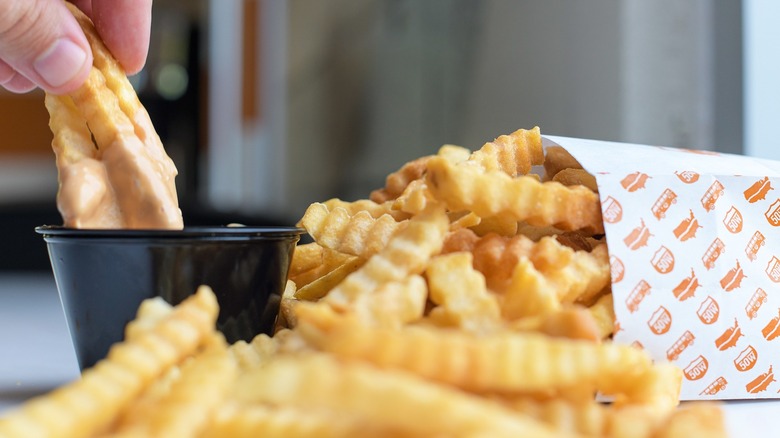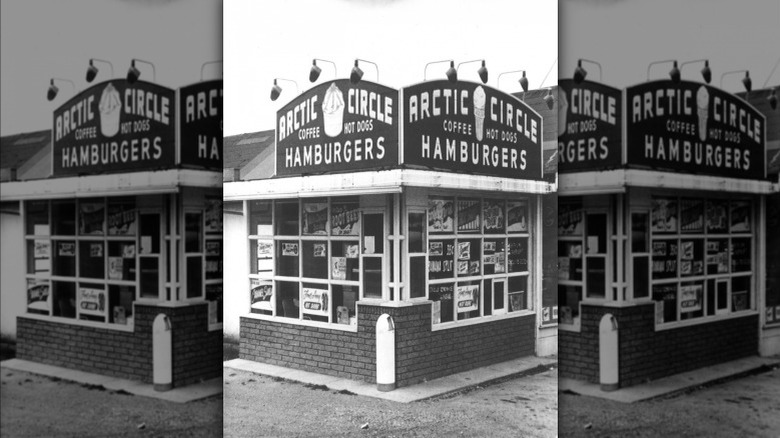Fry Sauce Has Been Around A Lot Longer Than You Think
The purpose of fry sauce is pretty self-evident. The ingredients involved might not be, but they're still fairly simple: ketchup and mayo. Other components are sometimes added in for extra flavor, but that's optional.
What we actually mean here by ketchup, though, is tomato ketchup. Originally, ancient Chinese ketchup paste consisted of fish, meat, and soybeans. Besides, tomatoes weren't brought over from the New World to the Old World until the 16th century; and, even then, they took a couple of centuries to catch on in Western cuisine. By 1812, though, these two disparate foods finally collided, and tomato ketchup was born.
Mayonnaise is actually a bit older than tomato ketchup. Its backstory is debated, but the popular view is that mayo was invented in 1756 by a chef searching for a way to celebrate their duke's latest military victory. Realizing they were out of cream, this chef instead used the olive oil they had on hand; and, thus, mayo was officially born.
Of course, mayonnaise couldn't be combined with tomato ketchup until the latter was also invented. Plus, it's not as if these two immediately met as soon as they both existed. Even so, modern fry sauce has been around a lot longer than you may think.
Fry sauce is beloved in the Beehive State
In the present-day United States, ketchup plus mayo is the most famous in Utah. There, the restaurant chain Arctic Circle reigns as the (disputed) champion of fry sauce. Other chains like Burger King, Dairy Queen, Five Guys, McDonald's, and Smashburger have all carried the stuff at various points in time. Even condiments like Raising Cane's own Cane Sauce could arguably be categorized as fry sauce, as well. Still, Arctic Circle supposedly comes out on top by having beaten those other chains to the punch.
The common narrative is that Arctic Circle's founder, Don Carlos, invented the stuff around the mid-20th century. Originally, he topped burgers with ketchup and mayo, separately, and ended up combining the two beforehand to save time. Initially, this was called pink sauce; but, over time, customers fell in love with the condiment and started dipping their fries in it — thus, the new name.
It's worth noting that there is a more complex backstory, one which was reported on by the Deseret News, the Beehive State's oldest journalistic publication. As told to them by the grandson of Don Carlos, it was actually two workers at a franchise who first mixed together ketchup and mayo at an Arctic Circle. Don Carlos approved, and the sauce became standard; but then another franchise modified the recipe, replacing the mayonnaise with Arctic Circle's secretive mayo-based White Sauce. This was both efficient and tasty.
So, the rest was history — or was it?
Fry sauce is not the first of its kind
The fact that both mayonnaise and tomato ketchup existed by 1812 means there was well over a century during which fry sauce could have been concocted, well before Arctic Circle had the idea. So, did no one else really ever think to mix ketchup and mayo together? Well, it seems that they did, and Utah was likely not the stage for the original fry sauce. Some other American locales may be responsible; folks in Idaho occasionally claim the Gem State invented it, and the U.S. territory of Puerto Rico has long had its own mayoketchup.
Indeed, there are various similar sauces that go by different names, but that doesn't mean they can't qualify as fry sauce. For example, Russian dressing uses ketchup and mayo in addition to spicier ingredients such as horseradish, onion, and Worcestershire sauce. Thousand Island dressing also employs mayo and tomatoes. Both of those dressings originated in the United States during the early 1900s, prior to when Don Carlos opened up his first restaurant.
It might not even be anywhere in the United States that fry sauce got its beginning, however. Global variations exist, such as burger sauce in the U.K., koktelisosa in Iceland, and salsa rosada in Columbia. Golf sauce in particular traces back to 1920s Argentina, which again predates Utah's fry sauce. It's hard to definitively state when fry sauce emerged on the scene, but we can certainly say it's been around for quite a while!


